[lwptoc]
Schedule 2 of Treasury Laws Amendment (A Tax Plan for the COVID-19 Economic Recovery) Act 2020 — which received Royal Assent on 14 October 2020 — inserted Div 160 into the ITAA 1997 which contains the company loss carry back tax offset rules. An eligible corporate entity can choose to ‘carry back’ a tax loss it incurs in the 2019–20, 2020–21 or 2021–22 income years and offset it against the income tax liability of earlier income years as far back as the 2018–19 income year to generate a refundable tax offset. The rules are temporary — they apply in relation to assessments for the 2020–21 or 2021–22 income year and will cease to apply after the 2021–22 income year.
 NOT YET LAW
NOT YET LAW
As part of the 2021–22 Federal Budget, the Government announced that it will extend for one year the temporary loss carry-back measure. At the time of writing, this announcement has not been passed into law.
The limited nature of the concession is summarised below:
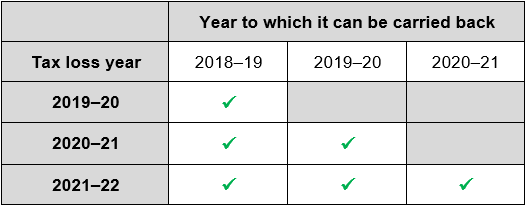
The choice to claim a loss carry back tax offset is an alternative to carrying tax losses forward as a deduction for future income years. The ability to carry back losses is useful for companies that have allowable deductions under, for example, the instant asset write-off, because it means that the company does not have to wait until it has a taxable income in order to benefit from the deductions. The significant tax losses which the instant asset write-off can generate can be carried back to generate cash refunds for eligible businesses.
The entity gets a refundable tax offset for 2020–21 or 2021–22 that is a proxy for the tax the entity would save if it deducted the loss in the income year to which the loss is carried back. The refundable tax offset is:
An entity will be eligible to claim a loss carry back tax offset if it:
The tax losses which can be carried back to an earlier income year (i.e. to the 2018–19, 2019–20 or 2020–21 income years) only if the entity had an income tax liability in that year. A tax loss can only be used once.
An entity cannot carry back:
The ATO has provided a four step process to calculate the amount of the loss carry back tax offset:
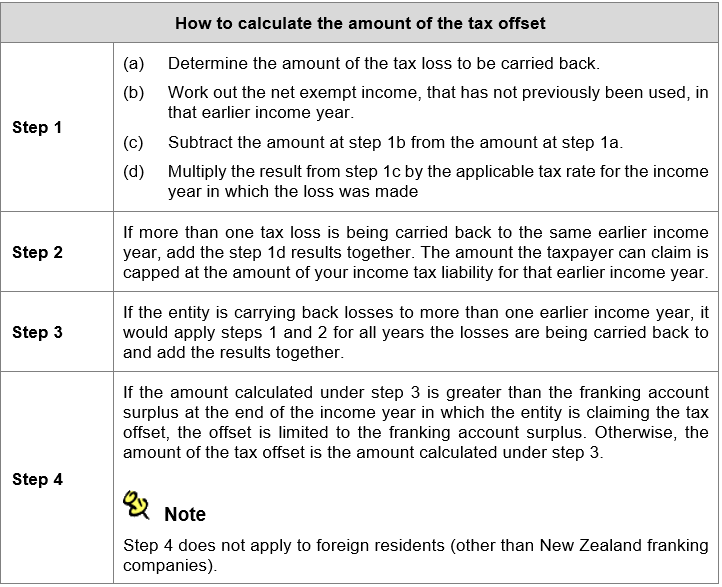
The following examples demonstrate the above four step methodology:
A company, a base rate entity (BRE), has a tax loss of $30,000 in the 2020–21 income year and an income tax rate of 26 per cent. Its turnover is $1 million.
At the end of its 2020–21 income year, it has a franking account balance of $12,000 and chooses to carry back all its tax loss from the 2020–21 income year to the 2019–20 income year.
In the 2019–20 income year, the company had an income tax liability of $16,000 and no exempt income.
The company calculates the amount of its tax offset for the 2020–21 income year as follows:
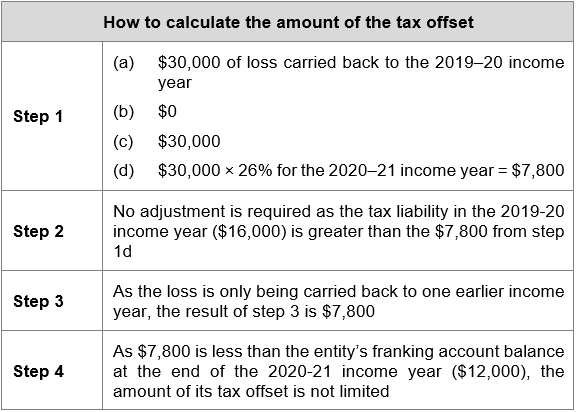
The company’s refundable tax offset from loss carry back is therefore calculated as $7,800.
A company (a BRE) has a tax loss of $500,000 in the 2020–21 income year and an income tax rate of
26 per cent. Its turnover is $2 million. It chooses to carry back the entirety of this loss to the 2019–20 and 2018–19 income years.
At the end of its 2020–21 income year, it has a franking account balance of $100,000.
The company had the following income tax liabilities in previous years:
The company calculates the amount of its tax offset for the 2020–21 income year as follows:
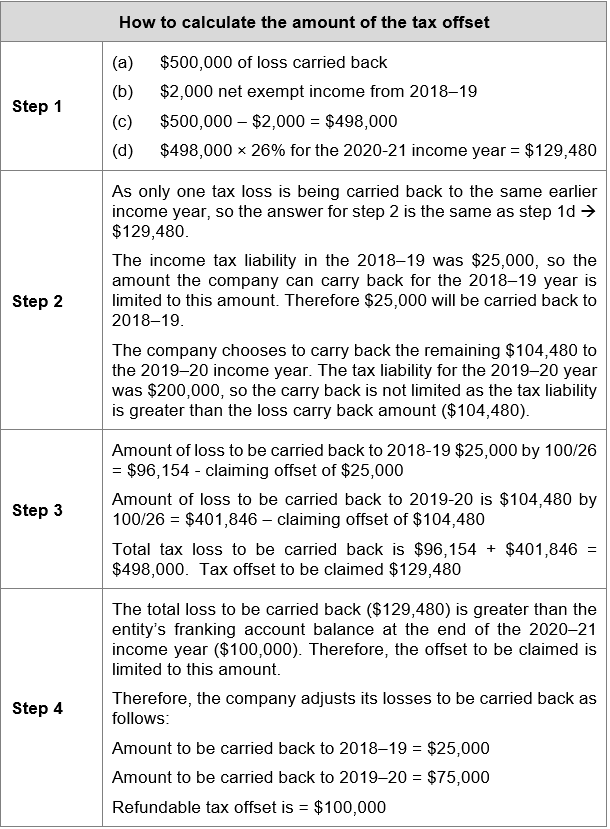
The company’s refundable tax offset from loss carry back is therefore calculated as $100,000.
Choice — $384,615 × $25,000 ÷ $100,000 = $96,154 loss carried back to 2018–19
Choice — $384,615 × $75,000 ÷ $100,000 = $288,461 loss carried back to 2019–20
On this basis, the company has a loss to be carried forward. $29,480 x 100/26 = $113,385. That is, the company has effectively carried back $498,000 – $113,385 = $384,615 to create the refund of $100,000 (at 26%).
A company claiming the loss carry back tax offset must complete additional labels in the Company tax return 2021 (NAT 0656-6.2021) to make the choice to carry back losses.
Entities with an early balancer substituted accounting period (SAP) and entities lodging a company tax return for part of the 2020–21 income year will be required to complete a ‘Loss carry back claim form — 2020–21 Early balancer substituted accounting period or lodging a company tax return for part year’ form (NAT 75344) in order to claim the tax offset.
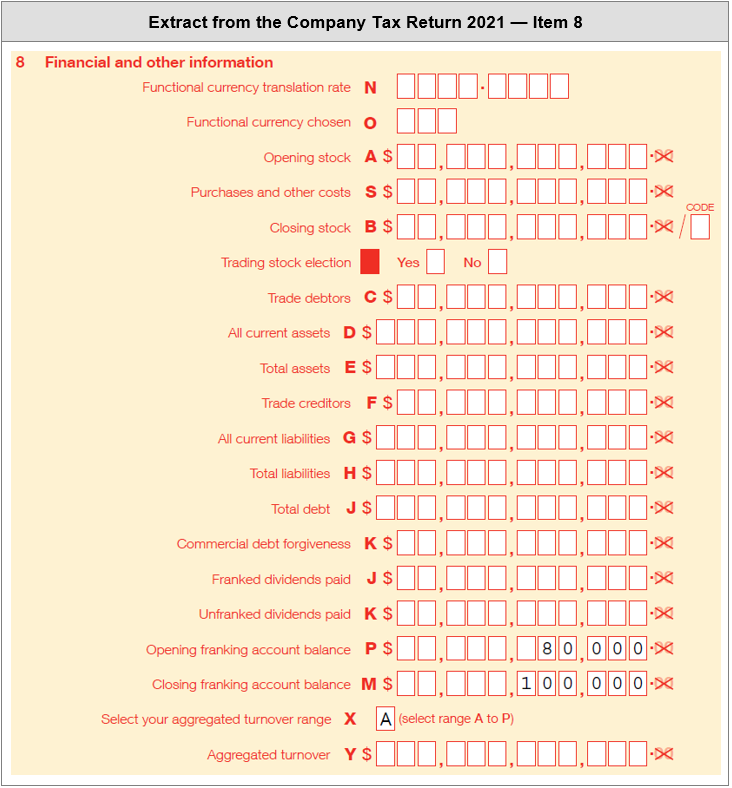
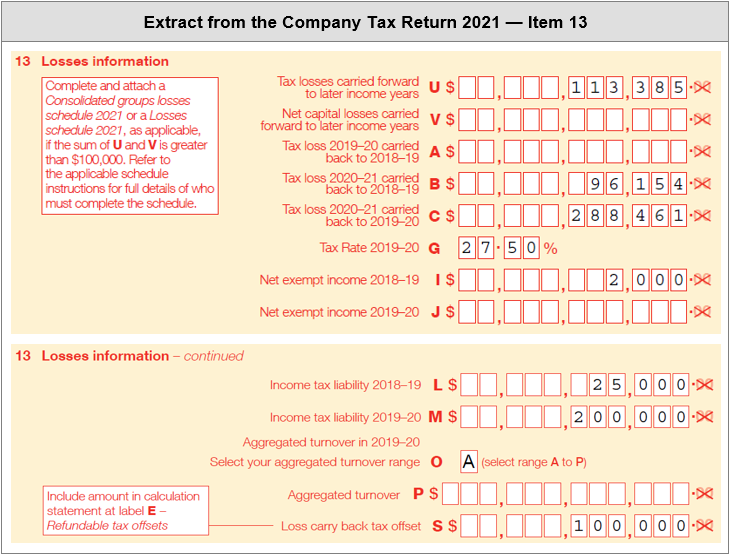
 Useful Resources
Useful Resources
Join us at the beginning of each month as we review the current tax landscape. Our monthly Online Tax Updates and Public Sessions are excellent and cost effective options to stay on top of your CPD requirements. We present these monthly online, and also offer face-to-face Public Sessions at locations across Australia. Click here to find a location near you.
Did you know?
We can also present these Updates at your firm (or through a private online session) with content tailored to your client base – please contact us here to submit an expression of interest or visit our In-house training page for more information.
Our mission is to offer flexible, practical and modern tax training across Australia – you can view all of our services by clicking here.
Join thousands of savvy Australian tax professionals and get our weekly newsletter.